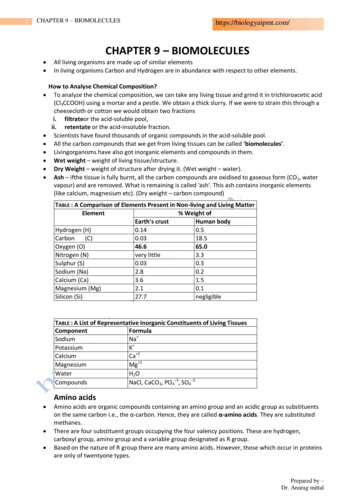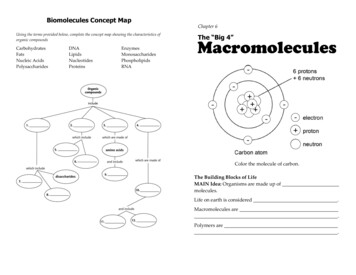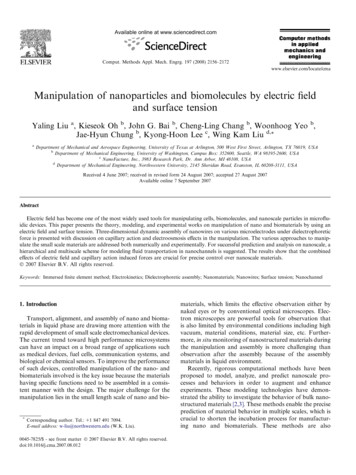
Transcription
1CHAPTER 9 – BIOMOLECULEShttps://biologyaipmt.com/CHAPTER 9 – BIOMOLECULES All living organisms are made up of similar elementsIn living organisms Carbon and Hydrogen are in abundance with respect to other elements.How to Analyse Chemical Composition?To analyze the chemical composition, we can take any living tissue and grind it in trichloroacetic acid(Cl3CCOOH) using a mortar and a pestle. We obtain a thick slurry. If we were to strain this through acheesecloth or cotton we would obtain two fractionsi. filtrateor the acid-soluble pool,ii. retentate or the acid-insoluble fraction.Scientists have found thousands of organic compounds in the acid-soluble pool.All the carbon compounds that we get from living tissues can be called 'biomolecules'.Livingorganisms have also got inorganic elements and compounds in them.Wet weight – weight of living tissue/structure.Dry Weight – weight of structure after drying it. (Wet weight – water).Ash – ifthe tissue is fully burnt, all the carbon compounds are oxidised to gaseous form (CO2, watervapour) and are removed. What is remaining is called 'ash'. This ash contains inorganic elements(like calcium, magnesium etc). (Dry weight – carbon compound)TABLE : A Comparison of Elements Present in Non-living and Living MatterElement% Weight ofEarth's crustHuman bodyHydrogen (H)0.140.5Carbon(C)0.0318.5Oxygen (O)46.665.0Nitrogen (N)very little3.3Sulphur (S)0.030.3Sodium (Na)2.80.2Calcium (Ca)3.61.5Magnesium (Mg)2.10.1Silicon (Si)27.7negligibleTABLE : A List of Representative Inorganic Constituents of Living TissuesComponentFormulaSodiumNa PotassiumK CalciumCa 2MagnesiumMg 2WaterH2OCompoundsNaCl, CaCO3, PO4–3, SO4–2Amino acids Amino acids are organic compounds containing an amino group and an acidic group as substituentson the same carbon i.e., the α-carbon. Hence, they are called α-amino acids. They are substitutedmethanes.There are four substituent groups occupying the four valency positions. These are hydrogen,carboxyl group, amino group and a variable group designated as R group.Based on the nature of R group there are many amino acids. However, those which occur in proteinsare only of twentyone types.Prepared by –Dr. Anurag mittal
2CHAPTER 9 – BIOMOLECULES R group hydrogen R group methyl group R group hydroxy methyl https://biologyaipmt.com/e.g., glycinee.g., alaninee.g., serine.The chemical and physical properties of amino acids are essentially of the amino, carboxyl and the Rfunctional groups. Acidic amino acid – glutamic acid etc. Basic amino acid – lysine Neutral amino acid – valine. aromatic amino acids – tyrosine, phenylalanine, tryptophan.A particular property of amino acids is the ionizable nature of-NH2 and -COOH groups. Hence insolutions of different pHs, the structure of amino acids changes.Lipids Lipids are generally water insoluble. They could be simple fatty acids.A fatty acid has a carboxyl group attached to an R group. The R group could be a methyl (-CH3), orethyl (-C2H5) or higher number of-CH2 groups (1 carbon to 19 carbons). Palmitic acid has 16 carbons including carboxyl carbon. Arachidonic acid has 20 carbon atoms including the carboxyl carbon.Fatty acids could be saturated (without double bond) or unsaturated (with one or more C C doublebonds).Another simple lipid is glycerol which is trihydroxy propane.Many lipids have both glycerol and fatty acids. Here the fatty acids are found esterified withglycerol. They can be then monoglycerides, diglycerides and triglycerides.These are also called fats and oils based on melting point. Oils have lower melting point (e.g., gingelyoil) and hence remain as oil in winters.Some lipids have phosphorous and a phosphorylated organic compound in them. These arephospholipids. They are found in cell membrane. Lecithin is one example.Some tissues especially the neural tissues have lipids with more complex structures.Prepared by –Dr. Anurag mittal
3CHAPTER 9 – BIOMOLECULEShttps://biologyaipmt.com/Nucleotides Many carbon compounds have heterocyclic rings like nitrogen bases -adenine, guanine, cytosine,uracil, and thymine.When found attached to a sugar, they are called nucleosides.(nucleoside sugar nitrogen base).Adenosine, guanosine, thymidine, uridine and cytidine are nucleosides.If a phosphate group is also found esterified to the sugar they are called nucleotides. (Nucleotides nucleosides phosphate). Adenylic acid, thymidylic acid, guanylic acid, uridylic acid and cytidylicacid are nucleotides.Nucleic acids like DNA and RNA consist of nucleotides only. DNA and RNA function as geneticmaterial.PRIMARY AND SECONDARY METABOLITES Primary metabolites – Biomolecules which are present in all organisms and have identifiablefunctions and play known roles in normal physiologial processes.Secondary metabolites – In plants, fungus and microbes many compounds other than primarymetabolites are present. e.g,alkaloides, flavonoides, rubber, essential oils, antibiotics,colouredpigments, scents, gums, spices. The role or functions of all the secondary metabolitesare not knownyet. many of them are useful to 'human welfare' (e.g., rubber, drugs, spices, scents and pigments).Some secondary metabolites have ecological importance.Prepared by –Dr. Anurag mittal
4CHAPTER 9 – BIOMOLECULEShttps://biologyaipmt.com/TABLE : Some Secondary MetabolitesPigmentsCarotenoids, Anthocyanins, etc.AlkaloidsMorphine, Codeine, etc.TerpenoidesMonoterpenes, Diterpenes etc.Essential oilsLemon grass oil, etc.ToxinsAbrin, RicinLectinsConcanavalin ADrugsVinblastin, curcumin, etc.Polymeric substances Rubber, gums, celluloseBIOMACROMOLECULES There is one feature common to all those compounds found in the acid soluble pool. They havemolecular weights ranging from 18 to around 800 daltons (Da) approximately. (Micromolecules)(Mw 1000 daltons)The acid insoluble fraction, has only four types of organic compounds i.e., proteins, nucleic acids,polysaccharides and lipids. These classes of compounds with the exception of lipids, have molecularweights in the range of ten thousand daltons and above. (Macromolecules) (Mw 1000 daltons)The molecules in the insoluble fraction with the exception of lipids are polymeric substances.Lipids are small molecular weightcompounds and are present not only as such but also arranged intostructures like cell membrane and other membranes. When we grind a tissue, we are disrupting thecell structure. Cell membrane and other membranes are broken into pieces, and form vesicles whichare not water soluble. Therefore, these membrane fragments in the form of vesicles get separatedalong with the acid insoluble pool and hence in the macromolecular fraction. Lipids are not strictlymacromolecules.The acid soluble pool represents roughly the cytoplasmic composition. The macromolecules fromcytoplasm and organelles become the acid insoluble fraction. Together they represent the entirechemical composition of living tissues or organisms.TABLE : AverageComposition of CellsComponent% of the total cellular massWater70-90Proteins10-15Carbohydrates 3Lipids2Nucleic acids 5-7Ions1PROTEINS Proteins are polypeptides. They are linear chains of amino acids linked by peptide bonds.Each protein is a polymer of amino acids. As there are 21 types of amino acids (e.g., alanine,cysteine, proline, tryptophan, lysine, etc.), a protein is a heteropolymer and not a homopolymer.A homopolymer has only one type of monomer repeating 'n' number of times.Amino acids can be essential or non-essential. Essential amino acids are supplied in diet while ourbody prepares non essential amino acids.Proteins carry out many functions in living organisms, some transport nutrients across cellmembrane, some fight infectious organisms, some are hormones, some are enzymes,etc.Collagen is the most abundant protein in animal world.Ribulose bisphosphate Carboxylase-Oxygenase (RUBISCO) is the most abundant protein in the wholeof the biosphere.Prepared by –Dr. Anurag mittal
5CHAPTER 9 – BIOMOLECULEShttps://biologyaipmt.com/TABLE : Some Proteins and their FunctionsProtein FunctionsCollagen Intercellular ground substanceTrypsin EnzymeInsulin HormoneAntibody Fights infectious agentsReceptor Sensory reception (smell, taste, hormone, etc.)GLUT-4 Enables glucose transport into cells POLYSACCHARIDESPolysaccharides are long chains of sugars. They are threads (literally a cotton thread) containingdifferent monosaccharides as building blocks.Celluloseis a polymeric polysaccharide consisting of only one type of monosaccharide i.e., glucose.Cellulose is a homopolymer.Starch is a variant of this but present as a store house of energy in plant tissues. Animals haveanother variant called glycogen.Inulin is a polymer of fructose.In a polysaccharide chain (say glycogen), the right end is called the reducing end and the left end iscalled the non-reducing end. It has branches.Starch forms helical secondary structures. In fact, starch can hold I2 molecules in the helical portion.The starch-I2 is blue in colour. Cellulose does not contain complex helices and hence cannot hold I 2.Plant cell walls are made of cellulose. Paper made from plant pulp is cellulose. Cotton fibre iscellulose.There are more complex polysaccharides in nature. They act as building blocks, amino-sugars andchemically modified sugars (e.g., glucosamine, N-acetyl galactosamine, etc.).Exoskeletons of arthropods, for example, have a complex polysaccharide called chitin. Thesecomplex polysaccharides are heteropolymers.Fig: Structure of a part of Glycogen.Prepared by –Dr. Anurag mittal
6CHAPTER 9 – BIOMOLECULEShttps://biologyaipmt.com/NUCLEIC ACIDS Present in acid insoluble fraction of all living tissues.These are polynucleotides. For nucleic acids, the building block is a nucleotide. A nucleotide hasthree chemically distinct components. One is a heterocyclic compound (N2 bases, the second is amonosaccharide and the third a phosphoric acid or phosphate.)Adenine, Guanine, Uracil, Cytosine, and Thymine are N2 containing bases. Adenine and Guanine aresubstituted purines while the rest are substituted pyrimidines.The sugar found in polynucleotides is either ribose (a monosaccharide pentose) or 2' deoxyribose.A nucleic acid containing deoxyribose is called deoxyribonucleic acid (DNA) while that whichcontains ribose is called ribonucleic acid (RNA).STRUCTURE OF PROTEINS Proteins are heteropolymers containing strings of amino acids. \Biologists describe the protein structure at four levels. Primary structure –It is linear structure of protein.the left end represented by the first amino acid and the right end represented by the last aminoacid.The first aminoacid is also called as N-terminal amino acid. The last amino acid is called theC-terminal amino acid. Secondary structure –The linear protein thread is folded in the form of a helix (similar to a revolving staircase).Inproteins, only right handed helices are observed. Tertiary structure –The long protein chain is also folded upon itself like a hollow wollen ball, giving rise to thetertiary structure. This gives us a 3-dimensional view of a protein. Tertiary structure is absolutelynecessary for the many biological activities of proteins. Quaternary structure –Some proteins are an assembly of more than one polypeptide or subunits. The manner in whichthese individual folded polypeptides or subunits are arranged with respect to each other (e.g.linear string of spheres, spheres arranged one upon each other in the form of a cube or plateetc.) is the architecture of a protein otherwise called the quaternary structure of a protein.e.g., Adulthuman haemoglobin consists of 4 subunits. Two of these are identical to each other.Hence, two subunits of α type and two subunits of β type together constitute the humanhaemoglobin (Hb).Fig: Primary structure of proteinPrepared by –Dr. Anurag mittal
7CHAPTER 9 – BIOMOLECULEShttps://biologyaipmt.com/Fig: (a) Secondary structure (b) Tertiary structure of proteinNATURE OF BOND LINKING MONOMERS IN A POLYMER In a polypeptide or a protein, amino acids are linked by a peptide bond which is formed when thecarboxyl (-COOH) group of one amino acid reacts with the amino (-NH2) group of the next aminoacid with the elimination of a water moiety (the process is called dehydration).In a polysaccharide the individual monosaccharides are linked by a glycosidic bond. This bond is alsoformed by dehydration. This bond is formed between two carbon atoms of two adjacentmonosaccharides.In a nucleicacid a phosphate moiety links the 3'-carbon of one sugar of one nucleotide to the5'-carbon of the sugar of the succeeding nucleotide. The bond between the phosphate and hydroxylgroup of sugar is an ester bond. As there is one such ester bond on either side, it is calledphosphodiester bond.Nucleic acids exhibit a wide variety of secondary structures.one of the secondary structures exhibited by DNA is the famous Watson-Crick model.Watson-Crick Model According to this model DNA exists as a double helix. The two strands of polynucleotides areantiparallel i.e., run in the opposite direction.The backbone is formed by the sugar-phosphate-sugar chain.The nitrogen bases are projected more or less perpendicular to this backbone but face inside.A and G of one strand compulsorily base pairswith T and C, respectively, on the other strand.There are two hydrogen bonds between A and T. There are three hydrogen bonds between Gand C.Each strand appears like a helical staircase.Each step of ascent is represented by a pair of bases. At each step of ascent, the strand turns36 .One full turn of the helical strand would involve ten steps or ten base pairs.On drawing a line diagram, the pitch would be 34Å. The rise per base pair would be 3.4Å. Thisform of DNA with the above mentioned salient features is called B-DNA.There are more than a dozen forms of DNA named after English alphabets with uniquestructural features.Prepared by –Dr. Anurag mittal
8CHAPTER 9 – BIOMOLECULEShttps://biologyaipmt.com/Fig: Secondary structure of DNADYNAMIC STATE OF BODY CONSTITUENTS - CONCEPT OF METABOLISM living organisms contain thousands of organic compounds. These compounds or biomolecules arepresent in certain concentrations (expressed as mols/cell or mols/litre etc.).allthese biomolecules have a turn over. This means that they are constantly being changed intosome other biomolecules and also made from some other biomoleculesthrough chemical reactions.Together all these chemical reactions are called metabolism.These metabolic reactions result in the transformation of biomolecules like removal of CO2 fromamino acids making an amino acid into an amine, removal of amino group in a nucleotide base;hydrolysis of a glycosidic bond in a disaccharide, etc.Majority of these metabolic reactions are always linked to some other reactions or the metabolitesare converted into each other in a series of linked reactions called metabolic pathways.Flow of metabolites through metabolic pathway has a definite rate and direction. This metaboliteflow is called the dynamic state of body constituents.Another feature of these metabolic reactions is that every chemical reaction is a catalysed reaction.There is no uncatalysed metabolic conversion in living systems.The catalysts which hasten the rate of a given metabolic conversation are also proteins. Theseproteins with catalytic power are named enzymes.METABOLIC BASIS FOR LIVING Metabolic pathways can lead to a more complex structure from a simpler structure (for example,acetic acid becomes cholesterol) anabolic pathways,or lead to a simpler structure from a complexstructure (for example, glucose becomes lactic acid in our skeletal muscle) catabolic pathways.Anabolic pathways, as expected, consume energy. While, catabolic pathways lead to the release ofenergy, which is stored in the form of chemical bonds in ATP(adenosine triphosphate).THE LIVING STATE Many chemical compounds or metabolites, or biomolecules, are present at concentrationscharacteristic of each of them.e.g., the blood concentration of glucose in a normal healthy individual is 4.5-5.0 mM, while that ofhormones would be nanograms/ mL.all living organisms exist in a steady-state characterised by concentrations of each of thesebiomolecules. These biomolecules are in a metabolic flux. Any chemical or physical process movesspontaneously to equilibrium.The steady state is a non-equilibirium state. Because systems at equilibrium cannot perform work.Prepared by –Dr. Anurag mittal
9CHAPTER 9 – BIOMOLECULES https://biologyaipmt.com/the living state is a non-equilibrium steady-state to be able to perform work; living process is aconstant effort to prevent falling into equilibrium. This is achieved by energy input. Metabolismprovides a mechanism for the production of energy. Hence the living state and metabolism aresynonymous. Without metabolism there cannot be a living state.ENZYMES Almost all enzymes are proteins. There are some nucleic acids that behave like enzymes. These arecalled ribozymes.An enzyme like any protein has a primary structure,secondary and the tertiary structure.In tertiary structure, the backbone of the protein chain folds upon itself, the chain criss-crosses itselfand hence, many crevices or pockets are made. One such pocket is the 'active site'.An active site of an enzyme is a crevice or pocket into which the substrate fits. Thus enzymes,through their active site, catalyse reactions at a high rate.Enzyme catalysts differ from inorganic catalysts in many ways. Inorganic catalysts work efficiently athigh temperatures and high pressures, while enzymes get damaged at high temperatures (above40 C).However, enzymes isolated from organisms who normally live under extremely high temperatures(e.g., hot vents and sulphur springs), are stable and retain their catalytic power even at hightemperatures (upto 80 -90 C). Thermal stability is thus an important quality of such enzymesisolated from thermophilic organisms.Chemical Reactions Chemical compounds undergo two types of changes.A physical change simply refers to a change in shape without breaking of bonds. This is a physicalprocess. Another physical process is a change in state of matter: when ice melts into water, or whenwater becomes a vapour.when bonds are broken and new bonds are formed during transformation, this will be called achemical reaction. For example: hydrolysis of starch into glucose is an organic chemical reaction.Rate of a physical or chemical process refers to the amount of product formed per unit time. It canbe expressed as: Rate can also be called velocity if the direction is specified.Rates of physical and chemical processes are influenced by temperature among other factors.A general rule is that rate doubles or decreases by half for every 10 C change in either direction.Catalysed reactions proceed at rates vastly higher than that of uncatalysed ones. e.g., In the absence of anyenzyme this reaction is very slow, with about 200 molecules of H2CO3 being formed in an hour.However, by using the enzyme carbonic anhydrase, the reaction speeds about 600,000 moleculesbeing formed every second.A multistep chemical reaction, when each of the steps is catalysed by the same enzyme complex ordifferent enzymes, is called a metabolic pathway. For example,Prepared by –Dr. Anurag mittal
10CHAPTER 9 – BIOMOLECULES https://biologyaipmt.com/This reaction is actually a metabolic pathway in which glucose becomes pyruvic acid through tendifferent enzyme catalysed metabolic reactions.This pathway provides different products in different conditions –In our skeletal muscle, under anaerobic conditions, lactic acid is formed.Under normal aerobic conditions, pyruvic acid is formed.In yeast, during fermentation, the same pathway leads to the production of ethanol (alcohol).How do Enzymes bring about such High Rates of Chemical Conversions?Enzymes, i.e. proteins with three dimensional structures including an 'active site', convert asubstrate (S) into a product (P). Symbolically, this can be depicted as:Substrate 'S' has to bind the enzyme at its 'active site' within a given cleft or pocket. The substratehas to diffusetowards the 'active site'.There is thus, an obligatory formation of an 'ES' complex. E stands for enzyme. This complexformation is a transient phenomenon.During the state where substrate is bound to the enzyme active site, a new structure of thesubstrate called transition state structure is formed.Very soon, after the expected bond breaking/making is completed, the product is released from theactive site. In other words, the structure of substrate gets transformed into the structure ofproduct(s).There could be many more 'altered structural states' between the stable substrate and the product.all otherintermediate structural states are unstable.Stability is something related to energy status of themolecule or the structure.If 'P’ is at a lower level than'S', the reaction is anexothermic reaction. One need not supply energy (byheating) in order to form the product.However, whether it is an exothermic or spontaneousreaction or an endothermic or energy requiring reaction,the 'S' has to go through a much higher energy state ortransition state.The difference in average energy content of'S' from thatof this transition state is called 'activation energy'.Enzymes eventually bring down this energy barriermaking the transition of'S' to 'P' more easy.Nature of Enzyme ActionEach enzyme (E) has a substrate (S) binding site in its molecule so that a highly reactiveenzyme-substrate complex (ES) is produced. This complex is short-lived and dissociates into itsproduct(s) P and the unchanged enzyme with an intermediate formation of the enzyme-productcomplex (EP).The formation of the ES complex is essential for catalysis.The catalytic cycle of an enzyme action can be described in the following steps:1.First, the substrate binds to the active site of the enzyme, fitting into the active site.2.The binding of the substrate induces the enzyme to alter its shape, fitting more tightly aroundthe substrate.3.The active site of the enzyme, now in close proximity of the substrate breaks the chemicalbonds of the substrate and the new enzyme- product complex is formed.4.The enzyme releases the products of the reaction and the free enzyme is ready to bind toPrepared by –Dr. Anurag mittal
11CHAPTER 9 – BIOMOLECULEShttps://biologyaipmt.com/another molecule of the substrate and run through the catalytic cycle once again.Factors Affecting Enzyme ActivityFactors affecting Enzyme activity are temperature, pH, change in substrate concentration or bindingof specific chemicals that regulate its activity.1.Temperature and pHEnzymes generally function in a narrow range of temperature and pH.Each enzyme shows its highest activity at a particular temperature and pH called the optimumtemperature and optimum pH.Low temperature preserves the enzyme in a temporarily inactive state whereas high temperaturedestroys enzymatic activity because proteins are denatured by heat.2.Concentration of SubstrateWith the increase in substrate concentration, the velocity of the enzymatic reaction rises at first. Thereaction ultimately reaches a maximum velocity (Vmax) which is not exceeded by any further rise inconcentration of the substrate. This is because the enzyme molecules are fewer than the substratemolecules and after saturation of these molecules, there are no free enzyme molecules to bind withthe additional substrate molecules.The activity of an enzyme is also sensitive to the presence of specific chemicals that bind to theenzyme. When the binding of the chemical shuts off enzyme activity, the process is called inhibitionand the chemical is called an inhibitor.Competitive inhibition –When the inhibitor closely resembles the substrate in its molecular structure and inhibits the activityof the enzyme, it is known as competitive inhibitor. Due to its close structural similarity with thesubstrate, the inhibitor competes with the substrate for the substrate-binding site of the enzyme.Consequently, the substrate cannot bind and as a result, the enzyme action declines,e.g., inhibition of succinic dehydrogenase by malonate which closely resembles the substratesuccinate in structure.Such competitive inhibitors are often used in the control of bacterial pathogens.Fig: Effect of change in (a) pH, (b) temperature (c) Concentration of substrate on enzyme activityClassification and Nomenclature of EnzymesEnzymes are divided into 6 classes each with 4-13 subclasses and named accordingly by a four-digitnumber.1. Oxidoreductases/dehydrogenases: Enzymes which catalyse oxidoreduction between two substratesS and S' e.g.,2. Transferases: Enzymes catalysing a transfer of a group, G (other than hydrogen) between a pair ofsubstrate S and S' e.g.,3. Hydrolases: Enzymes catalysing hydrolysis of ester, ether, peptide, glycosidic, C-C, C-halide or P-NPrepared by –Dr. Anurag mittal
12CHAPTER 9 – BIOMOLECULEShttps://biologyaipmt.com/bonds.4. Lyases: Enzymes that catalyse removal of groups from substrates by mechanisms other thanhydrolysis leaving double bonds.5. Isomerases: Includes all enzymes catalysing inter-conversion of optical, geometric or positionalisomers.6. Ligases: Enzymes catalysing the linking together of 2 compounds, e.g., enzymes which catalysejoining of C-O, C-S, C-N, P-O etc. bonds.Co-factors Enzymes are composed of one or several polypeptide chains. However, there are a number of casesin which non-protein constituents called co-factors are bound to the enzyme to make the enzymecatalytically active.In these instances, the protein portion of the enzymes is called the apoenzyme.Three kinds of cofactors may be identified: prosthetic groups, co-enzymes and metal ions.Prosthetic groups are organic compounds and are distinguished from other cofactors in that theyare tightly bound to the apoenzyme.For example, in peroxidase and catalase, which catalyze the breakdown of hydrogen peroxide towater and oxygen, haem is the prosthetic group and it is a part of the active site of the enzyme.Co-enzymes are also organic compounds but their association with the apoenzyme is only transient,usually occurring during the course of catalysis. Furthermore, co-enzymes serve as co-factors in anumber of different enzyme catalyzed reactions. The essential chemical components of manycoenzymes are vitamins, e.g., coenzyme nicotinamide adenine dinucleotide (NAD) and NADP containthe vitamin niacin.Metal ions – A number of enzymes require metal ions for their activity which form coordinationbonds with side chains at the active site and at the same time form one or more cordination bondswith the substrate, e.g., zinc is a cofactor for the proteolytic enzyme carboxypeptidase.Catalytic activity is lost when the co-factor is removed from the enzyme which testifies that theyplay a crucial role in the catalytic activity of the enzyme.Prepared by –Dr. Anurag mittal
chapter 9 – biomolecules All living organisms are made up of similar elements In living organisms Carbon and










